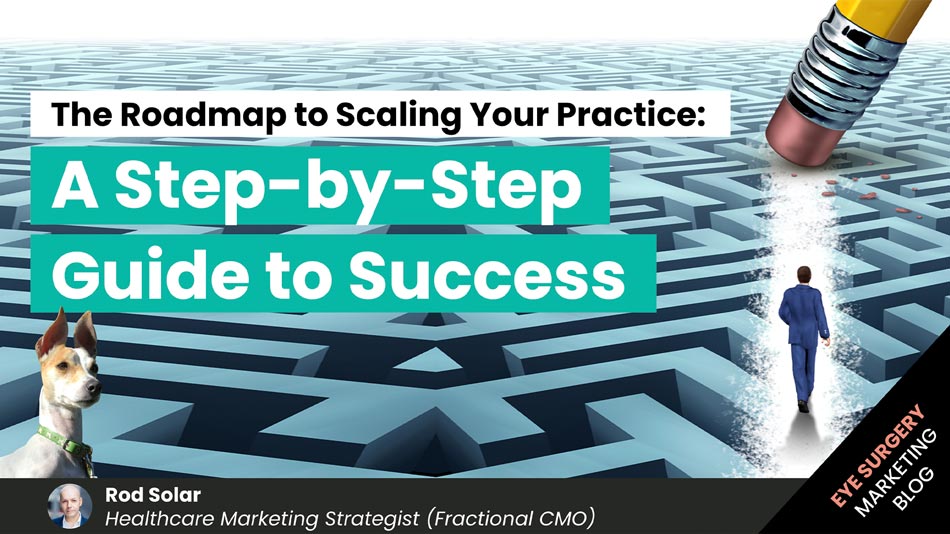
The Roadmap to Scaling Your Practice: A Step-by-Step Guide to Success
Scaling a practice from 1 to 3 million in revenue is a significant accomplishment, but it can be challenging to achieve without the support of your team.
Unfortunately, small practice owners looking to scale their practices often encounter resistance from their teams, which may be overworked and resistant to change.
However, there are steps that small practice owners can take to communicate their vision effectively, manage their team’s concerns, and get their buy-in into the change process.
This blog post will explore these steps and provides change management principles to help small practice owners successfully scale their practices.
First, nail how you can predictably create successful patients
Before any small business can successfully scale, it is essential to have a clear understanding of what conditions and actions create successful customers.
This process involves mapping out the customer journey and identifying the critical stages that lead to customer success.
Once you have identified these stages, the next step is to assign responsibilities to the appropriate team members and ensure everyone understands what customer success looks like and is aligned with the overall goal of creating successful customers.
| Key takeaway: Mapping your growth and fulfillment processes can be eye-opening. That’s why we do this first with every new customer, following the kick-off meeting. |
|---|
In refractive surgery, mapping out the customer journey involves identifying the stages a prospective patient goes through, from initial awareness of your product and service to becoming a happy and successful customer. These stages may include awareness, engagement, subscription, conversion, excitement, ascension, advocacy, and promotion. For each stage, it is essential to identify the critical actions or touchpoints that lead to customer success.
Delegating accountability to your team
Once you’ve mapped the customer journey, the next step is to assign responsibilities to the appropriate team members. This may involve assigning roles and responsibilities for each stage of the customer journey, such as marketing, sales, customer service, and support.
It is essential to ensure that everyone understands their role and is aligned with the overall goal of creating successful customers.
By documenting the most critical stages of the customer journey and assigning responsibilities to the appropriate team members, a practice can feel comfortable that it can reproduce its success.
This process also provides a roadmap for future growth and can help identify areas for improvement. As a result, a practice can be confident in its ability to scale and achieve its growth goals.
Creating playbooks anyone can follow
Creating a playbook for each critical stage of the customer journey is only part of the equation for successfully scaling a business.
It is equally important to ensure that the right people are in the right seats and are aligned with the company’s values and goals. One effective way to achieve this is by conducting regular one-on-one and quarterly performance reviews.
| Key takeaway: Creating playbooks (SOPs, Policies and Procedures) is essential for scaling. However, don’t assume you must document every little thing the practice does to complete this step.
Focusing on 20% of the steps that create 80% of the value is a better investment of your time, and will prevent you from shying away from this significant commitment. |
|---|
Establishing an accountability rhythm with your team
Weekly 1:1 reviews allow managers to check in with each team member, provide feedback on their performance, and discuss any concerns or challenges they may face. It is also an opportunity to ensure that everyone is aligned with the company’s goals and values and is working towards the same objectives.
Quarterly performance reviews provide a more in-depth look at each team member’s performance over a more extended period. During these reviews, managers can evaluate individual performance, provide feedback on areas for improvement, and set goals for the upcoming quarter. This process helps to ensure that team members are productive and aligned with the company’s values and goals.
Once you evaluate individual performance, it is important to bring the team together regularly to ensure that everyone is aware of the company’s overall goals and initiatives. A regular meeting rhythm consisting of weekly, monthly, and quarterly team meetings is an effective way to achieve this.
Weekly team meetings allow the team to review progress toward weekly goals, discuss any challenges, and collaborate on solutions. Monthly team meetings provide a more in-depth look at progress towards monthly goals and an opportunity to pivot on any longer-term initiatives. Quarterly team meetings are an opportunity to review progress towards quarterly goals, celebrate successes, and plan for the upcoming quarter.
By conducting regular 1:1 and performance reviews and implementing a regular meeting rhythm, a practice can ensure that the right people are in the right seats, aligned with the company’s values and goals, and working towards the same objectives. This process helps to create a culture of accountability, collaboration, and continuous improvement, which is essential for successfully scaling a practice.
NOTE: The best way to answer that nagging question about practice growth or marketing or patient volume in the back of your mind is to book a free 15-minute compatibility call. Get some options and go away with a clear idea of what’s possible.
Measuring what matters and continuously raising the bar
In addition to creating key stage playbooks and ensuring that the right people are in the right seats, it is also important to identify key metrics and create a practice dashboard to track and evaluate performance.
Tracking performance against key metrics is essential for achieving growth targets and identifying areas for improvement.
The first step in this process is to identify the key metrics that are most important for the practice. These metrics may include revenue, customer acquisition cost, customer lifetime value, number of new bookings, and other key performance indicators (KPIs) relevant to the practice.
Once you have identified the key metrics, the next step is to create a practice dashboard that tracks performance against these metrics every week. The dashboard should be easily accessible to all team members and provide a clear view of progress toward targets.
On a weekly basis, team members should evaluate their performance against these metrics and make adjustments as necessary. By tracking performance every week, team members can quickly identify areas for improvement and take action to address them.
Every month, team members should evaluate their performance against key metrics and review progress toward monthly goals. This process helps to ensure that the team is on track to achieve its objectives and helps you identify any areas for improvement.
Every quarter, team members should review performance against key metrics and evaluate progress towards quarterly goals. This process helps identify areas where targets are not being met and establish projects that aim to achieve those targets in the next quarter.
As the team achieves its targets consistently, it is important to raise the targets to maintain a steady growth rate. By continuously raising targets and challenging the team to achieve more, the business can achieve sustained growth over the long term.
Communicating the vision
An important step in scaling a practice is communicating your vision effectively to your team. This vision should include the practice’s goals, strategies, and expectations for growth.
However, it is essential to communicate this vision in a way that is easy to understand and relatable to your team members. Here are a few tips on how to communicate your vision effectively:
- Use simple language: Avoid using jargon or technical terms that your team members may not understand.
- Be clear and concise: Keep your message short and to the point. Avoid rambling or going off-topic.
- Use visuals: Use charts, diagrams, or other visual aids to help explain your vision.
- Tell a story: Use storytelling techniques to help your team members understand why scaling the practice is essential.
Managing your team’s concerns
Once you have communicated your vision, it is essential to manage your team’s concerns effectively. These concerns may include fears about job security, workload, or changes in the company’s culture. Here are some tips on managing your team’s concerns:
- Listen to your team: Encourage your team members to express their concerns and listen actively to what they have to say.
- Be transparent: Be open and honest about the changes happening in the practice. Avoid sugarcoating or hiding information from your team members.
- Address concerns individually: Take the time to speak with each team member individually and address their specific concerns.
- Be patient: Change can be challenging for some team members. Be patient and give them time to adjust.
Getting team buy-in
Getting team buy-in is essential for scaling a business successfully. Without the support of your team members, it will be difficult to achieve your goals. Here are some tips on how to get team buy-in:
- Create a shared vision: Involve your team members in the vision-setting process. Encourage them to provide input and feedback.
- Communicate the benefits: Help your team members understand the benefits of scaling the business. This could include increased job security, more significant career opportunities, or a better work-life balance.
- Provide training and development opportunities: Provide training and development opportunities to help your team members develop the skills they need to succeed in a larger organisation.
- Celebrate successes: Celebrate your team’s successes along the way. This will help to keep them motivated and engaged in the process.
The road to 3 million
The road to 3 million will be challenging, but with a good “why”, you’ll bring the necessary ambition to play your part. Importantly, you needn’t do this alone.
If you are hovering at around 1 million in annual revenue and need help
- Documenting your journey,
- Creating key stage playbooks,
- Ensuring that the right people are in the right seats,
- Keeping everyone aligned with the company’s values and goals, and working towards the same objectives.
- Conducting regular 1:1 and performance reviews and implementing a regular meeting rhythm,
- Creating a culture of accountability, collaboration, and continuous improvement, which is essential for successfully scaling a practice
Inquire with us about how we can help by scheduling a compatibility call.
NOTE: The best way to answer that nagging question about practice growth or marketing or patient volume in the back of your mind is to book a free 15-minute compatibility call. Get some options and go away with a clear idea of what’s possible.
About the author

Rod Solar
Founder & Scalable Business Advisor / fCMO
Rod Solar is a co-founder of LiveseySolar and a Scalable Business Advisor for its customers. Rod mentors and coaches eye surgery business CEOs/Founders and their leadership teams to triple their sales, double their profit, and achieve their “ideal exit”.
Related Posts
Meet our Co-Founders
We’re passionate about helping leaders of high-quality, growth-minded practice owners double their practice revenue

Rod Solar
Founder & Scalable Business Advisor
For over 20 years, I’ve helped ophthalmology entrepreneurs scale their private practices. I specialise in doubling revenue within three years by offering a proven framework, hands-on experience, and a team of experts who implement what works. We take the guesswork out of growth and scale, so you can focus on delivering exceptional patient care while maximising the value of your business.
LiveseySolar completely transformed the way we were approaching this… We’ve gone from having just the dream of having a practice to having a practice up and running with people making inquiries and booking for procedures… It’s extremely pleasing. We feel lucky we connected with LiveseySolar.
— Dr Matthew Russell, MBChB, FRANZCO, specialist ophthalmic surgeon and founder of VSON and OKKO

Laura Livesey
Founder & CEO
I’m the co-founder & CEO of LiveseySolar. I’ve developed powerful eye surgery marketing systems that increase patient volumes and profits for doctors, clinics, and hospitals, since 1997.
Rod and Laura know as much about marketing surgery to patients as I know about performing it. They are an expert in the field of laser eye surgery marketing. They know this industry inside out. I believe that they could help many companies in a variety of areas including marketing materials, sales training and marketing support for doctors.
— Prof. Dan Reinstein, MD MA FRSC DABO, founder of the London Vision Clinic, UK











